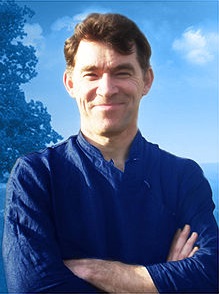Guest writer for Wake Up World
2006 was a difficult year for me and my wife. In April our second child, Ted, was born. Ted was a lovely baby (and is a lovely boy now), but he seemed to be born without the need to sleep. At night it was difficult to settle him down, and when he finally did settle, it was usually only for a short time. He would usually wake several times throughout the night, every hour or so, and my wife and I would take turns getting up.
This is quite common with new babies, of course, but with Ted it went on for a long time. I was working as a college tutor while working to meet the deadline for a book, and I soon became exhausted (although not as exhausted as my wife). We also had Ted’s three-year-old brother to look after. Eventually, probably due to the stress, I became seriously ill for the first time in my life, leading to two weeks in the hospital and an operation. Strangely enough, it was while I was in the hospital that Ted finally — after nearly nine months — settled down and began to sleep through the night.
During this time of turmoil and stress, I began to write poems, or short poetic spiritual reflections. I’ve always loved poetry, and in my teens and early 20s, I wrote a lot of poems and song lyrics (none of them particularly good). But it had been about 10 years since I’d written a poem. And the pieces that were starting to come through me now were different. They weren’t prose, but they weren’t exactly poems. They were poetic, but a little too loose and free to correspond to traditional concepts of poetry.
The pieces seemed to arrive from nowhere, as if they had been slowly gestating inside me for years, waiting for the right moment to emerge. Phrases would form in my mind, and when I sat down to write them down, other phrases would follow, until complete pieces formed in front of me. I was surprised by the voice which spoke in the pieces — a wise, assured voice, more weighty and profound than my normal writing style. I felt that this voice came from the deepest and highest part of me, and was able to express itself easily and directly.
Ever since then, poems and spiritual reflections have continued to flow through me. (Some of them are collected in my new book The Clear Light.)
Post-Traumatic Creative Growth
Years later, I began to wonder if there was any reason why I started to write these pieces. I think that there may well be a connection with the stress and turmoil of that period of my life. I’ve always been fascinated by the strong connection between psychological turmoil and spiritual transformation, which I explored in my book The Leap. Combined with an attitude of openness and acceptance, psychological turmoil can have a powerful awakening effect. This links to the well-researched phenomenon of post-traumatic growth, which shows that trauma can have long-term positive after effects, such as enhanced well-being, a sense of appreciation and connection, more intimate relationships, and so on.
It’s clear that psychological turmoil can have an awakening effect on creativity too. Musicians and writers sometimes find that their inspiration fades away when their lives are comfortable and stable, and that a period of turbulence — a breakup, illness, or depression — can reawaken their creativity. To give one example, Bob Dylan’s 1974 album Blood on the Tracks was heralded as a return to the height of his creative powers, after years of indifferent albums. The album emerged from the breakup of his marriage, with many of the songs describing his sorrow and grief.
In 2017, I led a study on the experiences of asylum seekers and refugees in the UK, and found high levels of trauma amongst them. The original trauma which led them to leave their homelands was overlaid with the trauma of trying to negotiate a hostile immigration system, with little or no support. At the same time, we found some evidence of post-traumatic growth in our sample. Significantly, we also found a very high level of creativity. Creativity seemed to serve both as a coping strategy and an expression of personal growth. Some participants had formed their own choir and sang regularly, while others practiced arts and crafts.
So in my own case, it may be that the turmoil of this period of my life led to psychological growth. The turmoil brought about an opening inside me and uncovered some latent creative potential.
The Suffering Artist
In her book When Walls Become Doorways, the psychologist Tobi Zausner shows that this is true of physical illness too (which in itself usually brings a great deal of psychological turmoil). Zausner describes myriad cases of artists whose creativity was enhanced by serious illness, including figures such as Michelangelo, Toulouse-Lautrec, Monet, Matisse, O’Keeffe, and Kahlo. Zausner compares a period of illness to a “creative chaos” which may initiate a transition to a new phase of heightened or different creativity. Illness creates new possibilities because it disrupts psychological equilibrium, breaks old habits, and forces artists to develop different creative strategies. As Zausner puts it, “life’s lowest moments can hold our greatest potential for creativity and transformation. When the wall of illness becomes a door of opportunity, the worst of times can bring out the best in us.”
All of this suggests that there is some basis for the myth of the “suffering artist.” Artists are usually not people who have always been stable and contented. It is likely that, at some point in their lives, they have been through periods of intense psychological and/or physical suffering. However, the myth of the suffering artist is perhaps misleading in the sense that artists do not generally produce great work while they are in the midst of suffering, but afterwards. They produce great art once they have passed through suffering and undergone growth and integration as a result of it. In other words, it is not suffering itself that produces great art, but the psychological growth that arises from suffering.
Trauma can break us down, but it can also break us open. It can unlock hidden potential inside us, open up new abilities and character strengths. It’s almost as if, when trauma and turmoil break us down, there is an opportunity for us to reform at a high level of order, to fuse back together in a more integrated and higher-functioning way. Or as I put it in one of the pieces from The Clear Light:
Trauma can break you down to nothing
destroy the identity you spent your whole life building up
like an earthquake that leaves you in ruins;
or trauma can transform you,
break open new depths and heights of your being
give rise to a greater structure, a miraculous new self —
and the only difference between them is acceptance.
Originally published at Psychology Today and reproduced with permission.
Recommended articles by Steve Taylor, Ph.D:
- Do Psi Phenomena Exist? A Debate (Part One)
- Do Psi Phenomena Exist? The Debate Continues
- David Ditchfield’s Remarkable Near Death Experience
- Waking Up – Are Spiritual Experiences Becoming More Common?
- The Guru Syndrome: When Spirituality Turns Sour
- Can Suffering Make Us Stronger?
- Transformation Through Dying: The Aftermath of Near Death Experiences
- Elation: The Amazing Effect of Witnessing Acts of Kindness
- The Power of Forgiveness: The Transformational Effect of Letting Go of Resentment
- The Power Of Silence
About the author:
Steve Taylor is a senior lecturer in Psychology at Leeds Beckett University, UK. His latest books in the US are The Calm Center and Back to Sanity: Healing the Madness of the Human Mind. He is also the author of The Fall, Waking From Sleep, and Out Of The Darkness. His books have been published in 19 languages. His research has appeared in The Journal of Transpersonal Psychology, The Journal of Consciousness Studies, The Transpersonal Psychology Review, The International Journal of Transpersonal Studies, as well as the popular media in the UK, including on BBC World TV, The Guardian, and The Independent.
Connect with Steve at StevenMTaylor.com.

If you've ever found value in our articles, we'd greatly appreciate your support by purchasing Mindful Meditation Techniques for Kids - A Practical Guide for Adults to Empower Kids with the Gift of Inner Peace and Resilience for Life.
In the spirit of mindfulness, we encourage you to choose the paperback version. Delve into its pages away from screen glare and notifications, allowing yourself to fully immerse in the transformative practices within. The physical book enriches the learning process and serves as a tangible commitment to mindfulness, easily shared among family and friends.
Over the past few years, Wake Up World has faced significant online censorship, impacting our financial ability to stay online. Instead of soliciting donations, we're exploring win-win solutions with our readers to remain financially viable. Moving into book publishing, we hope to secure ongoing funds to continue our mission. With over 8,500 articles published in the past 13 years, we are committed to keeping our content free and accessible to everyone, without resorting to a paywall.








